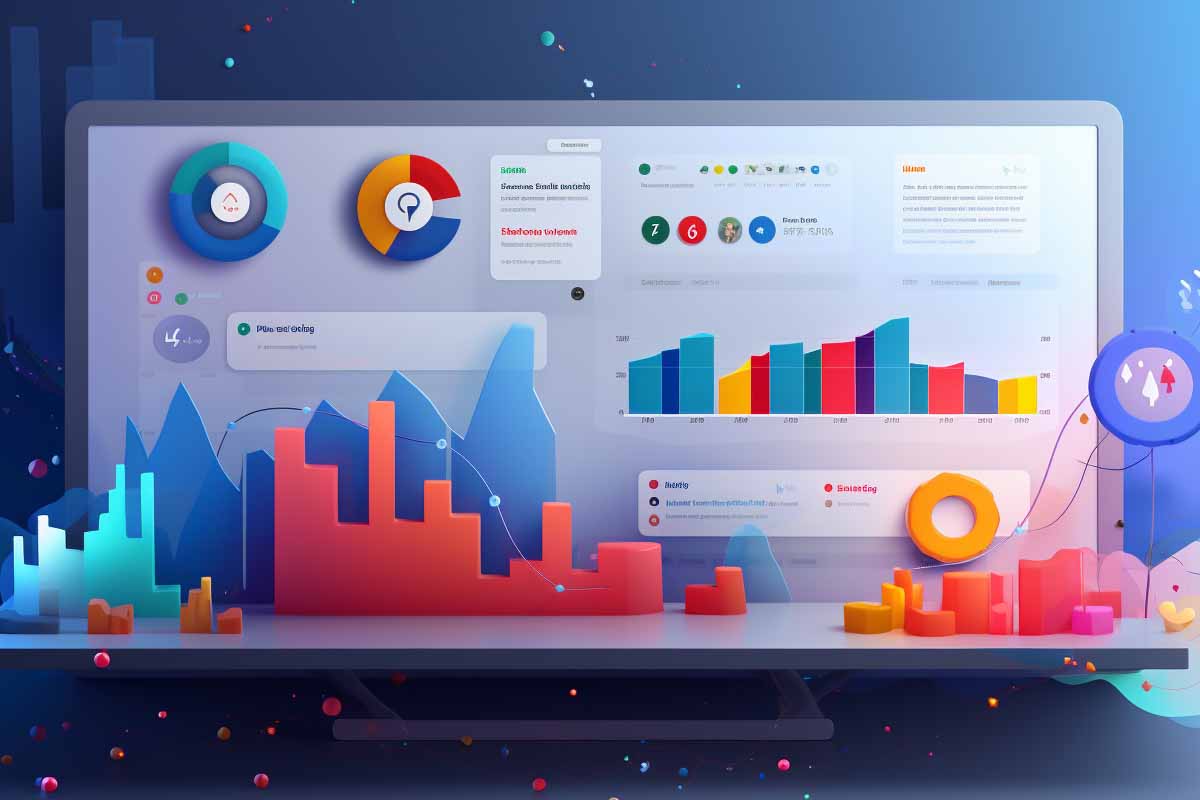What is Data Informed Decision Making?
Data Informed Decision Making involves utilizing data and information to guide and support business decisions. It is a systematic approach that combines objective data analysis and subjective human judgment to make informed choices. Data informed decision making ensures that decisions are rooted in evidence rather than intuition or assumptions. By collecting, analyzing, and interpreting data, organizations can gain valuable insights and make more strategic and confident decisions. This approach is becoming increasingly important in today’s data-driven and technologically advanced business landscape, as it enables companies to leverage their data assets to drive growth, improve customer experiences, and achieve their business goals. By embracing data informed decision making, organizations can gain a competitive edge and drive smarter business decisions.
Benefits of Using a Data-Informed Approach
A data-informed approach to decision-making is crucial for businesses looking to make informed and impactful choices. By relying on accurate and relevant information, businesses can avoid making decisions based on gut feelings or assumptions. Instead, they can utilize data to guide their choices and ensure they are making the best possible decisions.
One of the major benefits of a data-informed approach is the ability to uncover unique solutions and identify trends. Data can provide insights and patterns that may not be immediately apparent, allowing businesses to take advantage of opportunities and address challenges in innovative ways. This approach enables businesses to stay ahead of the curve and make decisions that align with emerging trends in their industry.
Overcoming stakeholder influence is another advantage of a data-informed approach. By relying on data, businesses can make decisions based on objective information rather than personal or political agendas. This helps ensure that choices are made in the best interest of the business and its goals, rather than being swayed by individual preferences.
Furthermore, being proactive in decision-making through a data-informed approach allows businesses to anticipate and respond to changes in the market. By leveraging data, businesses can make confident decisions that are rooted in evidence, reducing the risk of making choices based on guesswork or outdated information.
In conclusion, the benefits of using a data-informed approach are numerous. It allows businesses to make decisions based on accurate information, uncover unique solutions, identify trends, overcome stakeholder influence, and be proactive in decision-making. By embracing a data-informed approach, businesses can make smarter choices that lead to success and drive their business forward.
Gain Valuable Insights With Microsoft Power BI Training
Out extensive course allows you to harness the power of Microsoft Power BI. Gaining valuable insights into your business with power analytics is critical to sucess.
Gathering Relevant Data
Gathering Relevant Data: A Key Component of Data-Informed Decision Making
In order to make informed decisions, businesses must first gather relevant data. This involves collecting and analyzing various types of data that are pertinent to the decision-making process. This can include customer feedback, market trends, performance metrics, and more. By gathering and analyzing this data, businesses can gain valuable insights to guide their decision-making. This process allows them to understand their customers better, identify opportunities for improvement, and make informed choices that align with their business goals. Gathering relevant data is a crucial step in the data-informed decision-making process, as it ensures that decisions are based on accurate and current information.
Identifying the Right KPIs
Identifying the Right KPIs: Building Data Stories for Efficient Decisions
Key Performance Indicators (KPIs) are invaluable analytical tools that businesses use to measure the success of their strategic efforts. By tracking specific metrics, companies gain insights into various aspects of their operations, enabling them to make data-informed decisions and drive positive outcomes.
In the vast sea of available data, it is crucial to focus on selecting the right KPIs. Rather than overwhelming themselves with an excessive number of KPIs, businesses should narrow their focus to 5-8 key metrics that truly matter to their objectives. This approach allows for the creation of a compelling data story that portrays the most important elements of performance.
Streamlining the number of KPIs brings numerous benefits. It helps avoid cluttered dashboards and reports that can confuse decision-makers. Instead, a concise selection of KPIs ensures that relevant information is easily accessible and digestible.
The process of identifying the right KPIs is a strategic one. It requires a deep understanding of the company’s goals, industry benchmarks, and the specific metrics that directly impact desired outcomes. By carefully selecting KPIs, businesses can build a data-driven approach that empowers them to make efficient decisions, align their efforts with their goals, and drive success.
In conclusion, identifying the right KPIs is a key component of data-informed decision-making. By focusing on a select few metrics that build a compelling data story, businesses can streamline their analytical efforts and make more efficient decisions that positively impact their bottom line.
Setting Up Data Collection Systems
Setting up data collection systems is a crucial step in enabling data-informed decision making. By implementing robust data collection processes, businesses can gather relevant and accurate information that serves as the foundation for making informed choices.
Data collection systems allow companies to capture and organize data from various sources, such as customer interactions, sales transactions, website analytics, and more. This comprehensive approach ensures that businesses have a holistic view of their operations and can gather insights from multiple data points.
One effective way to organize and visualize this data is through the use of an executive dashboard. An executive dashboard consolidates key metrics and performance indicators into a single, easily digestible display. This visual representation allows decision-makers to quickly assess performance, identify trends, and evaluate the effectiveness of strategies.
A tip for optimizing data visualization is to use a universal reporting tool that allows customization of the executive dashboard. This ensures that the displayed data aligns with the specific needs and objectives of the business. Customization options such as choosing relevant KPIs, selecting visualization styles, and setting up alert notifications can further enhance the decision-making process.
In conclusion, setting up robust data collection systems, coupled with the use of an executive dashboard, enables businesses to gather relevant data, visualize it effectively, and make informed decisions. This data-informed approach empowers businesses to stay agile, adapt to changes, and achieve their goals.
Are You Getting The Most Out of Google Analytics 4 (GA4)?
GA4 is a powerful tool to analyze your business websites traffic and peformance. Learn to harness the true power of GA4 with our exclusive GA4 training course.
Determining What Data to Gather and Analyze
Determining What Data to Gather and Analyze for Data-Informed Decision Making
In order to make data-informed decisions, businesses must first determine what data to gather and analyze. This process involves several steps:
1. Define the objectives: Start by clearly defining the goals and objectives of the decision-making process. This will help identify the specific information needed to support those goals. For example, if the objective is to improve customer satisfaction, data related to customer feedback and preferences would be relevant.
2. Identify relevant data: Once the objectives are defined, identify the types of data that are most relevant to the decision-making process. This can include both internal and external data sources. Internal data sources may include data collected from customer surveys, sales transactions, website analytics, and other customer interactions. External data sources can include industry reports, market research, and historical trends.
3. Collect and analyze data: Gather the identified data from the various sources and analyze it to derive actionable insights. This may involve using analytical tools and techniques to uncover patterns, trends, and correlations that can provide valuable information for decision making.
4. Consider multiple perspectives: It is important to gather data from multiple sources to get a comprehensive view of the situation. This includes not only internal data but also external sources such as industry reports and market research. By considering a variety of perspectives, businesses can gain a more accurate and well-rounded understanding of the factors influencing their decision.
5. Emphasize creative thinking: While data is crucial for making informed decisions, it is also important to not solely rely on existing data. Creative thinking is necessary to identify new data sources and explore innovative ways to gather and analyze information. This can help businesses uncover fresh insights and identify opportunities that may not be immediately apparent from existing data.
In summary, determining what data to gather and analyze for data-informed decision making involves defining objectives, identifying relevant data from internal and external sources, collecting and analyzing data, considering multiple perspectives, and emphasizing creative thinking. By following these steps, businesses can make more informed decisions based on a comprehensive understanding of the relevant data.
Interpreting the Results of Your Analysis
Interpreting the results of your data analysis is a crucial step in making data-informed decisions for your business. After collecting and analyzing the data, it is important to examine the results and draw meaningful conclusions.
Start by considering what you already knew about the data. This can help you put the results into perspective and evaluate if they align with your expectations. Identify any new information or insights that you have learned from the analysis. These new findings can provide valuable input for your decision-making process.
Next, assess how the information gleaned from the data analysis can be used to meet your business goals. Look for patterns, trends, or correlations in the data that can guide your decision-making. For example, if the analysis reveals a high customer churn rate, you can conclude that there may be issues with customer satisfaction or loyalty. This insight can then be used to develop strategies to improve the customer experience and reduce churn.
To effectively interpret the results, consider creating analytical reports that highlight the key findings and insights. These reports should clearly communicate the implications of the data analysis and how it relates to your business goals. Visualizations such as charts and graphs can also help convey the results in a more digestible format.
By carefully interpreting the results of your analysis, you can derive meaningful insights that inform your decision-making process and help you achieve your business goals.
Taking Action on Insights Gained From Data Analysis
Once you have conducted a thorough analysis of your data and gained valuable insights, the next crucial step is to take action based on those insights. It is not enough to simply gather and analyze data; the real value lies in using that information to make informed decisions and drive business growth. By taking action on the insights gained from data analysis, you can address challenges, capitalize on opportunities, and make smarter business decisions. This requires identifying the key findings from the data analysis, understanding their implications, and developing strategies and initiatives based on the insights. It is important to communicate these insights to relevant stakeholders and ensure that there is a clear plan of action in place. By leveraging data to drive decision-making, businesses can optimize processes, improve customer experiences, enhance performance, and ultimately achieve their business goals.
Building an Actionable Plan Based on Insights Gained From Analysis
Building an actionable plan based on insights gained from analysis is a key component of data-informed decision-making. This process involves transforming raw data into valuable insights and then using those insights to guide and inform specific actions. By following a systematic approach, businesses can ensure that their actions are aligned with their goals and have a positive impact on their overall strategy.
To start, it is essential to have clearly defined goals. These goals should be specific and measurable, allowing for easy tracking of progress. With a clear understanding of what the business aims to achieve, it becomes easier to identify the key insights that will drive the decision-making process.
Once the insights have been identified, it is important to establish specific actions that will be taken to address them. These actions should be actionable and have a direct impact on the desired outcomes. It is also crucial to allocate responsibilities to individuals or teams to ensure accountability and facilitate smooth execution.
In addition to specific actions, a timeline should be set for the implementation of the plan. This timeline should take into account any dependencies, such as the availability of resources or the completion of other tasks. By setting a timeline, businesses can ensure that their actions are executed in a timely manner and progress towards their goals.
Finally, it is vital to set measurable outcomes and explain the expected impact of the plan. Measurable outcomes provide a benchmark for evaluating the success of the plan, while explaining the expected impact helps gain buy-in from stakeholders and ensures everyone is aligned on the desired results.
In conclusion, building an actionable plan based on insights gained from analysis involves setting clearly defined goals, establishing specific actions, allocating responsibilities, and setting a timeline for implementation. By following this process, businesses can make confident decisions that align with their goals and have a positive impact on their overall strategy.
Measuring Results of Action Taken to Monitor Progress and Impact
Measuring the results of actions taken to monitor progress and impact is a crucial component of implementing a data-driven approach. To effectively measure results, it is important to track key performance indicators (KPIs) and compare historical data with newly collected data.
KPIs provide quantifiable measures that reflect the success or progress of a specific goal or objective. By regularly tracking these KPIs, businesses can monitor their performance and make data-informed decisions. These indicators could include metrics such as revenue growth, customer acquisition cost, customer satisfaction rating, or website traffic.
Comparing historical data with new data allows businesses to assess the impact of their actions over time. By analyzing patterns and trends, businesses can identify areas of improvement and areas of success. This comparison provides valuable insights into the effectiveness of the decisions made.
Setting measurable goals is also crucial for effective decision making. By defining specific, quantifiable targets, businesses can track progress and measure the success of their actions accurately. When goals are measurable, it becomes easier to determine whether the actions taken have achieved the desired impact.
In conclusion, measuring the results of actions taken to monitor progress and impact is essential in implementing a data-driven approach. Tracking KPIs, comparing historical and new data, and setting measurable goals provide businesses with valuable insights to make informed decisions and drive success.
Adjusting Actions as Needed Based on New Insights from Continued Analysis and Feedback
Adjusting actions as needed based on new insights from continued analysis and feedback is a critical aspect of the data-informed decision-making process. Ongoing analysis and feedback provide businesses with valuable information to evaluate the effectiveness of their strategies and make necessary adjustments.
Continued analysis involves regularly monitoring key performance indicators (KPIs) and comparing them with previous data. By doing so, businesses can identify patterns, trends, and areas that require improvement. This analysis uncovers new insights that can inform decision-making and guide future actions.
Feedback, whether from customers, employees, or other stakeholders, provides a real-time perspective on how well strategies are working. Gathering feedback through surveys, reviews, or social media monitoring enables businesses to understand customer needs, preferences, and pain points. This feedback can reveal opportunities for improvement or highlight areas where adjustments need to be made.
When new insights are obtained through analysis and feedback, businesses can make informed adjustments to their strategies and plans. This could involve revising marketing campaigns, improving customer experiences, or refining business processes. By interpreting and responding to data insights, businesses can ensure that their actions are aligned with their goals and have a positive impact.
In conclusion, adjusting actions based on new insights from continued analysis and feedback is vital for making informed decisions. By staying vigilant, businesses can adapt their strategies to meet evolving needs, ultimately driving success and achieving their business goals.
Master Your Data Warehouse
For years Microsoft Analysis has been a folder standard for creating and maintain business intelligence databases. Take your skillset to the maximum level with our Microsoft SQL Analysis Services course.
Challenges of Implementing a Data-Driven Approach
While a data-driven approach offers numerous benefits, it is not without its challenges. One of the main obstacles businesses face is the need for the right tools and technology to effectively collect, analyze, and interpret data. Implementing a data-driven approach requires investing in robust data analytics platforms, customer data platforms, or business intelligence platforms that can handle large volumes of data and provide actionable insights. Additionally, organizations must ensure that they have the necessary skills and expertise to utilize these tools effectively. Training employees and hiring data analysts or data scientists may be necessary to fully leverage the power of data. Another challenge is overcoming resistance to change. Implementing a data-driven approach often requires a shift in mindset and culture, as decision-making becomes more data-informed rather than relying solely on intuition or experience. This can be met with resistance from employees who may be hesitant to adopt new processes or feel threatened by the increasing role of data in decision-making. Clear communication and leadership buy-in are essential to overcome these challenges and foster a data-driven culture within the organization. Finally, data quality and governance are critical factors for success. Inaccurate or unreliable data can lead to flawed insights and misguided decisions. Ensuring data integrity, data security, and adhering to privacy regulations are vital to establish trust in the data-driven approach and avoid potential risks. By addressing these challenges head-on, businesses can pave the way for successful implementation of a data-driven approach and reap the benefits of data-informed decision-making.
Ensuring Relevant, Accurate Information is Collected and Analyzed
In today’s data-driven world, businesses cannot afford to make decisions based on guesswork or assumptions. To make informed choices that drive success, it is crucial to collect and analyze relevant and accurate information. Implementing a data-informed decision-making approach provides numerous benefits, but it all begins with the quality of the data.
To truly understand the dynamics of your market and customers, data must be gathered from both internal and external sources. Internal data includes customer feedback, transaction records, and performance reviews, while external data comprises industry reports, market research, and customer surveys. By combining these sources, you can obtain a comprehensive view of your business landscape.
The quality of data is essential to make confident decisions. Inconsistent or inaccurate data can lead to flawed insights and misguided actions. To ensure data quality, it should be consistent, accurate, and relevant to the business goals. Regular data cleansing and validation processes should be implemented to eliminate any inaccuracies and inconsistencies.
Collecting and analyzing relevant and accurate information is the cornerstone of a successful data-informed decision-making approach. It provides valuable insights into customer behavior, market trends, and business performance. By making informed choices, businesses can create smarter strategies, improve customer experiences, and achieve their goals effectively.
Overcoming Resistance to Change within an Organization
Implementing a data-informed decision-making approach within an organization can often be met with resistance to change. However, there are strategies and approaches that can help overcome this resistance and drive successful adoption.
1. Clear Communication: Communication is key when introducing any new initiative. Leaders should clearly communicate the reasons behind the shift to a data-informed decision-making approach, emphasizing the potential benefits for the organization as a whole. This helps to create a shared understanding and generate buy-in from employees.
2. Education and Training: Offering education and training programs is crucial to ensure that employees understand the benefits of data-informed decision-making and feel equipped to utilize the available data effectively. Companies like Google have been successful in managing resistance to change by using data to identify behaviors and offering training programs that empower employees to make data-driven decisions.
3. Leadership Support: Leaders play a critical role in driving change within an organization. They should demonstrate their commitment to the data-informed decision-making approach by integrating it into their decision-making processes and setting an example for others to follow.
4. Addressing Concerns and Fears: Resistance to change often stems from underlying concerns and fears. Organizations should create a safe space for employees to voice their concerns and address them openly. By addressing these concerns and providing reassurance, organizations can help alleviate resistance.
5. Celebrating Success and Sharing Results: Recognizing and celebrating the successes achieved through data-informed decision-making can create a positive momentum within the organization. Sharing the positive impact of data-driven decisions with employees reinforces the value of the approach and encourages further adoption.
In conclusion, overcoming resistance to change when implementing a data-informed decision-making approach requires clear communication, education and training, leadership support, addressing concerns, and celebrating success. Companies like Google have effectively managed resistance to change by using data to identify behaviors and implementing training programs to enhance data literacy skills. By following these strategies and approaches, organizations can successfully navigate the transition towards data-informed decision-making.
Integrating Human Element into Decisions
Integrating the human element into data-informed decisions is of utmost importance for organizations seeking to make effective and meaningful choices. While data analysis provides valuable insights, it is crucial to recognize that decisions are ultimately made by humans. Factors such as values, experiences, and intuition cannot be overlooked in the decision-making process.
Values and experiences shape the way individuals perceive and interpret data. They guide individuals’ priorities and provide a moral compass in decision-making. By incorporating these elements, organizations can ensure that decisions align not only with the data but also with their core values and principles.
One strategy to integrate the human element is through the use of value maps. By mapping out the organization’s values and comparing them with the insights from data analysis, decision-makers can align their choices with their organizational mission and vision. Additionally, revisiting the organization’s mission, values, and goals can serve as a compass to guide decision-making and ensure that human insights are considered alongside data-driven analysis.
Moreover, organizations should create a culture that values diverse perspectives and encourages collaboration. By involving individuals from different backgrounds and experiences in the decision-making process, organizations can tap into the collective wisdom and foster innovative solutions.
In conclusion, combining data analysis with the human element is essential for meaningful and impactful decision-making. By integrating values and experiences into the decision-making process and aligning choices with the organization’s mission, values, and goals, organizations can ensure decisions that reflect a comprehensive and holistic perspective.
You might also like:
Big Data Salary: Unraveling the Earnings of Architects, Analysts, and Engineers
What is GUPT: Privacy Preserving Data Analysis Made Easy
Connect Power BI to Azure SQL DB – Unlocking Data Insights with Power BI and Azure SQL
SQL Data Types – Understanding The Differences
Understanding MLeap and Microsoft SQL Big Data
How can Data Informed Decision Making improve operational efficiency in organizations?
Data Informed Decision Making can enhance operational efficiency by identifying inefficiencies, bottlenecks, and areas for improvement. Analyzing operational data can lead to optimized processes, reduced costs, and increased productivity, ultimately leading to better overall performance.
What role does data visualization play in Data Informed Decision Making?
Data visualization is critical in Data Informed Decision Making as it helps present complex data in a visually appealing and easy-to-understand format. It enables decision-makers to identify patterns, trends, and outliers quickly, facilitating better insights and informed choices.
How does Data Informed Decision Making contribute to risk management?
Data Informed Decision Making allows organizations to assess and mitigate risks effectively. By analyzing historical data and market trends, businesses can identify potential risks, develop contingency plans, and make decisions that minimize negative impacts and maximize opportunities.
What are the ethical considerations in Data Informed Decision Making?
Ethical considerations in Data Informed Decision Making include ensuring data privacy, obtaining consent for data collection, using data for legitimate purposes, and avoiding biased decision-making based on sensitive attributes like race or gender. Adhering to ethical practices builds trust with customers and stakeholders.
How can small businesses leverage Data Informed Decision Making with limited resources?
Small businesses can leverage Data Informed Decision Making by starting with the data they already possess, such as customer feedback, sales records, or website analytics. They can use free or low-cost data analysis tools and focus on specific, achievable objectives to gain insights and make incremental improvements. Collaborating with local universities or hiring freelancers with data analysis expertise can also be cost-effective strategies.



























